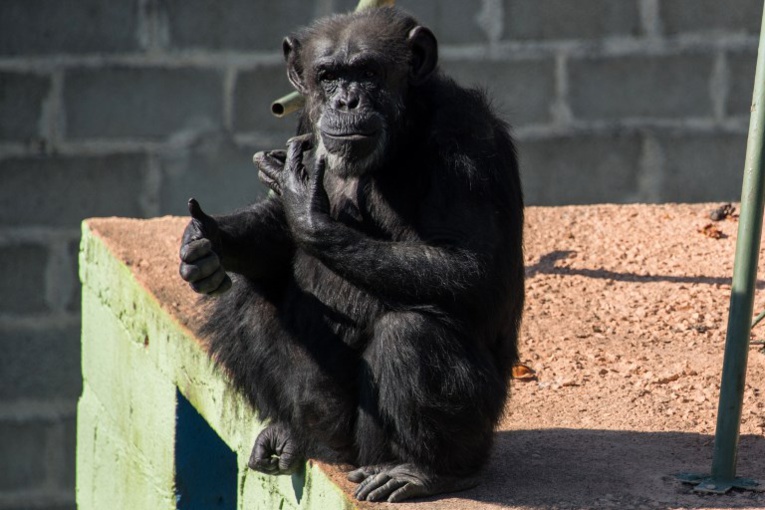Science
Related: About this forumChimpanzees have their own language -- and scientists just learned how they put "words" together
The discovery of a chimp group's 390-word "language" has profound implications for the evolution of human speech
By MATTHEW ROZSA
PUBLISHED MAY 22, 2022 7:30PM (EDT)

Three chimpanzees sitting in a group appear to have a meeting (Getty Images/curioustiger)
Few animals appear to be able to communicate with a range as complex and intricate as humans. Those language skills may exist in a limited capacity in our nearest evolutionary neighbors, the great apes, many of whom have been trained to communicate via sign language by human researchers. Yet while sign language is communicated physically, researchers did not believe that great apes possessed their own comparable, complex spoken language.
Until now, that is. A new study reveals that chimpanzees — or at least, a group of 46 chimpanzees at Taï National Park in the African country of Côte d'Ivoire — are capable of complex vocalizations far beyond what more pessimistic scientists thought was possible. Their "words" were not like human phonetic words, but a combination of chimpanzee sounds, which generally sound a bit like grunts and chirps to human ears. And the size of the chimp dictionary? Almost 400 words.
"Chimpanzees produced 390 unique vocal sequences," explained the scientists, who published their research in the journal Communications Biology. "Most vocal units emitted singly were also emitted in two-unit sequences (bigrams), which in turn were embedded into three-unit sequences (trigrams)."
For context, the average human 20-year-old English speaker knows an estimated 42,000 words, according to Science magazine.
The scientists suggest that the way the vocal sequences were arranged suggests they could come up with new words, too. "From a purely structural perspective, the capacity to organize single units into structured sequences offers a versatile system potentially suitable for expansive meaning generation," they write. "Further research must show to what extent these structural sequences signal predictable meanings."
More:
https://www.salon.com/2022/05/22/chimpanzees-have-their-own-language--and-scientists-just-learned-how-they-put-words-together/
Easterncedar
(3,582 posts)As always, I really appreciate your posting, Judi Lynn. That story is very intriguing. (I have to laugh at how hard it is to find the words to properly reply.) I followed the link back to another story about the oldest primates in the fossil record, found in Colorado. I had no idea! You make a bout of insomnia worthwhile. Thanks!
Random Boomer
(4,253 posts)That we are different in degree is self-evident, but I'm always fascinated to hear of another way in which we're more alike than is comfortable (at least for some people).
Warpy
(113,131 posts)Prairie dogs have a language, warning calls about humans distinguish sex, color of clothing, whether or not they're carrying a weapon, and a few other things. Some of their language has been deciphered.
I would imagine most intensely social animals have language. Some, like domestic dogs and cats, communicate mostly chemically, although both species try to talk back to us.
Eventually, if we don't blow ourselves up or fry the planet, we might be able to hear what some critters are saying.
Bayard
(24,145 posts)One chimp appears to be trying to sell the other two some magic beans.
Fascinating research.
BadgerKid
(4,683 posts)Igel
(36,165 posts)Worked with a linguist years ago.
She took on the news that some non-human primate species possessed language. The primate under study had learned words, used words, had elementary syntax, and even could innovate new words according to a productive morphological pattern.
She got the video footage, the raw data. And watched many hundreds of hours of it. Collected data. This took a few years.
In the end she had the data. The original study had cherry picked. Ignore when the subject mimics a human. Ignore all the gibberish, uninterpretable utterances like "me wants banana give banana give banana me me banana banana not not banana give not me not banana not want not give give want not want" while sitting in a corner alone right after eating. All the data descended into non-significance once *all* the data were included, not just the data that fit.
Advocacy science.
The original study is still widely quoted. The disconfirmation was really quite definitive--*all* the tapes were reviewed--and that's what linguists have usually used. Although I can't vouch for the last generation.
I'll wait for confirmation of this study. Which, to be honest, depending on the amount of available (not just "used"![]() data and hesitancy to say something unpopular, might take years.
data and hesitancy to say something unpopular, might take years.
Judi Lynn
(162,437 posts)By Dr. Tim Sandle
Published June 4, 2022

In 2017 a court in Argentina granted this female chimpanzee Cecilia the right not to be imprisoned without trial, under habeas corpus - Copyright AFP/File CHAIDEER MAHYUDDIN
Research into chimpanzees finds that the primates combine calls to form numerous vocal sequences, indicating further step in understanding the sophisticated language of chimpanzees.
At the first level, how animals communicate with each other appears quite simple. Yet also remains an area of uncertainty as to how our language evolved from such a simple system.
Scientists at the Max Planck Institute for Evolutionary Anthropology report on how they have found evidence of structured vocal sequences in wild chimpanzee communication. Not only does this advance undemanding about chimpanzees, it also provides insights into human language evolution.
People communicate using hierarchically structured sentences, yet where this capacity originates from, is unknown. Clues as to the evolutionary origins of human language are commonly sought using a comparative approach, such as studying the vocal production of other animals.
Read more: https://www.digitaljournal.com/tech-science/learning-from-chimps-insights-into-the-structure-of-language/article#ixzz7VIbNVzuu